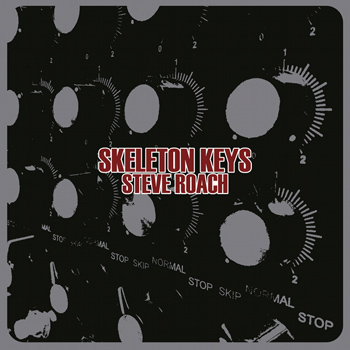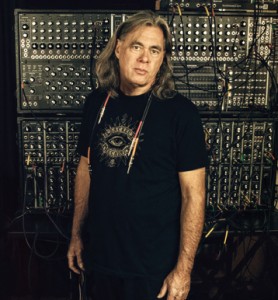“We shall not cease from exploration, and the end of all our exploring will be to arrive where we started and know the place for the first time.” T.S. Elliott
 Hear Steve Roach talk about Skeleton Keys tonight on Echoes.
Hear Steve Roach talk about Skeleton Keys tonight on Echoes.
As Steve Roach’s Skeleton Keys opens, with a reverse sequencer pattern fading-in as if going backwards in time, this quote struck me because Roach is returning to his analog synthesizer sequencer roots. But since Roach has been relentlessly discovering new music directions for 35 years, when he revisits these sounds, he hears it anew, discovering innovative pathways in an old vocabulary.
Steve Roach is a child of German space music. Tangerine Dream, Klaus Schulze and Ash Ra Tempel (sic) were his Holy Trinity and he expanded on that sound with albums like Now, Traveler and his definitive sequencer statement, Empetus. While many artists were content to stay in that mode, Roach crossed the border into a new world of sound, developing techno-tribal with Dreamtime Return, deep drone with Magnificent Void, and galactic expansion on albums like Arc of Passion. Elements of those 1980s sequencer pulses would return, radically shifted, on albums like Proof Positive and Light Fantastic (a CD of the Month in 2000), but they have been secondary or understated elements on the 50 or so solo albums Roach released since Empetus in 1986.
THE ONLY WAY IN
 When “The Only Way In” opens the door to Skeleton Keys, a wash of familiarity rushes in, but it’s a sound that is also altered by a quarter century of musical evolution. There’s a more tribal, percussive approach to these analog-driven tracks that wasn’t present in 1986. The nature of Roach’s interwoven sequencer patterns has also changed. They’re more intricate and transformative, a fractal moiré pattern of shifting perspectives and deceptive depths. Roach slowly alters sequencer patterns in a track, changing focus, bringing one element into bas relief then re-submerging it into the pattern. It’s a fascinating display of electronic painting that reveals a minimalist element to this music that owes more to Steve Reich’s “Music for 18 Musicians” than Tangerine Dream’s “Phaedra.”
When “The Only Way In” opens the door to Skeleton Keys, a wash of familiarity rushes in, but it’s a sound that is also altered by a quarter century of musical evolution. There’s a more tribal, percussive approach to these analog-driven tracks that wasn’t present in 1986. The nature of Roach’s interwoven sequencer patterns has also changed. They’re more intricate and transformative, a fractal moiré pattern of shifting perspectives and deceptive depths. Roach slowly alters sequencer patterns in a track, changing focus, bringing one element into bas relief then re-submerging it into the pattern. It’s a fascinating display of electronic painting that reveals a minimalist element to this music that owes more to Steve Reich’s “Music for 18 Musicians” than Tangerine Dream’s “Phaedra.”
This might be the only Roach album that displays its technology like a trophy. Roach composed Skeleton Keys on a massive analog synthesizer constructed in the style of early Moog modulars, with tons of switches, knobs and patch bays. An extreme close-up photo of a few knobs on the instrument graces the cover and a promotional postcard has Roach standing in front of it, the huge synthesizer spilling beyond the frame. A lot of artists are going in this direction these days, but few have the mastery and control that Steve Roach reveals.
THE FUNCTION INSIDE THE FORM
Most of the compositions’ titles relate to Roach’s sonic structures. “Escher’s Dream Is Dreaming” features sequencer patterns that seem to turn on themselves, and “Symmetry and Balance” reflects interlocking notes that mirror, refract and move contrapuntally through time. “It’s All Connected” is both a philosophical construct and a commentary on Roach’s music: the piece is built upon a techno-tribal flow of acoustic sounding percussion, matched by a twanging, nattering electronic pattern, a marriage of his two dominant worlds.
A SUBTLE TWIST OF FATE
Sonically and sensually, Skeleton Keys is as immersive as anything Steve Roach has recorded and is best heard loud on good speakers or headphones, as patterns bounce across the stereo spectrum in lysergic pirouettes. These Skeleton Keys will unlock your consciousness.
~John Diliberto
More on Steve Roach
Steve Roach on 30th Anniversary of Structures from SIlence
5 Essential Steve Roach CDS
Steve Roach Icon of Echoes

I started listening to electronic music after discovering then Walter Carlos’ ‘Switched On Bach’ at the library back in the late 60’s IIRC. I also did the Kingsley-Perrey cut n paste LP, which my older sister played for me. I discovered Tangerine Dream after the Rolling Stone review of ‘Phaedra’. I have had an abiding if interrupted continuing relationship with TD ever since and up to Edgar’s death. The Klaus Schulze LPs manged to escape my attention until the late 80’s and as such missed a bit of their significance until stumbling over a recording of ‘Crystal Lake’. Listening to the tracks you have posted above by Mr. Roach brings all the good memories of the past sequencer runs up to date and in another way move them forward to the future. Thank you. I must go now and purchase this album.
I’m not sure if I found Steve’s music at 13 years old 33 years ago or if the soundworld found me. Perhaps a combination of both.
What staggers me most about Steve’s creative process is how he incorporates a quality of revelation to his work as he creates it. His faith in the mystery of what awaits inside the sounds that emerge provide him the range and flow necessary for expansionistic nuances that almost have a mind of their own. Jerry Garcia said the song plays the band. This characterizes the way the music Steve brings it into being. The word ecstasy came from the original meaning to “step aside.” The “ecstatic” is to leave the familiar. Just before playing live I asked Steve what he was planning, he said, “i’m just as curious as you are as to what will unfold.” The alacrity in his approach reminds me of a collective trust that forms when you play from a more “macro place” where the people, the space itself, his readiness, all commune into a formative, braided path that sound paints itself true through Steve’s creative process.For this, Steve has taught me how to listen from a wider reception to life; to occupy a “peripheral listening.” The riverbed beneath Steve’s creative process is built upon this like an apparatus or holding space like carriage from which flow patterns of energy and information come into a natural order. Skeleton Key’s is one of the most direct relationships to this formative field that I’ve ever witnessed through Steve. It is as intimate as ever to his truest work and self all in one. Skeleton keys is the process of something new and old waiting to be born. Even more, the pieces have a sense of ownership by the listener, it is in Steve’s generosity to offer creations that can belong to the listener to recall the deeper soundings of their true inheritance. I often like to write from the hotbed of Steve’s pieces, here’s what Skeleton Key’s inspired:
Life is a mystery because you cannot predict a future, you can only create one. To do this, everything sustains your courage. Everything is the combination of your self, your life, and your service communing in a gravitational, braided way. The mystery is the quality of revelation given to you as you listen from an emerging future possibility and lead from it. The road is seen, then not seen. The way is hiding then revealing the way forward. Everything is welcome, nothing is expected. But don’t wait. Act instantly. The road leaves you to walk on thin air, and then hold you up when you thought you could fall. The future brought you to this place. Every step along the way you kept the heart and promise of what drew you in. You are far greater by the simple wish of what you sought as the end point, only to find what is there in the end was actually there when you started, yet experiencing it as if it was the first time with new eyes.